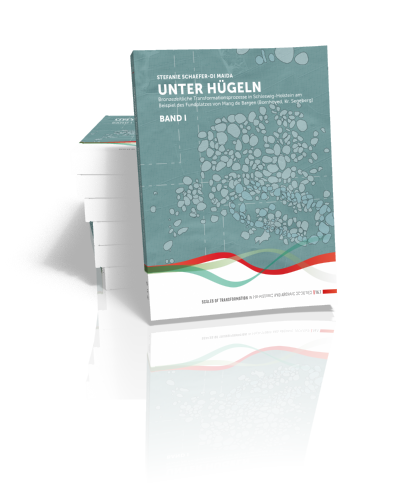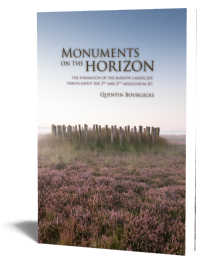Unter Hügeln (BAND 1)
Bronzezeitliche Transformationsprozesse in Schleswig-Holstein am Beispiel des Fundplatzes von Mang de Bargen (Bornhöved, Kr. Segeberg)
Stefanie Schaefer-Di Maida | 2023

Unter Hügeln (BAND 1)
Bronzezeitliche Transformationsprozesse in Schleswig-Holstein am Beispiel des Fundplatzes von Mang de Bargen (Bornhöved, Kr. Segeberg)
Stefanie Schaefer-Di Maida | 2023
Paperback ISBN: 9789464280487 | Hardback ISBN: 9789464280494 | Imprint: Sidestone Press Dissertations | Format: 210x280mm | 540 pp. | Scales of Transformation 16.1 | Series: Scales of Transformation | Language: German | 9 illus. (bw) | 164 illus. (fc) | Keywords: bronze age; northern Germany; funerary archaeology; chronology; burial rites; barrows; urnfields; radiocarbon dating; anthropology; palynology; archaeobotany | download cover | DOI: 10.59641/q9013tc
Read online or downloaded 735 times
-
Digital & Online access
This is a full Open Access publication, click below to buy in print, browse, or download for free.
-
Buy via Sidestone (EU & UK)
-
Buy via our Distributors (WORLD)
For non-EU or UK destinations you can buy our books via our international distributors. Although prices may vary this will ensure speedy delivery and reduction in shipping costs or import tax. But you can also order with us directly via the module above.
UK international distributor
USA international distributor
-
Bookinfo
Paperback ISBN: 9789464280487 | Hardback ISBN: 9789464280494 | Imprint: Sidestone Press Dissertations | Format: 210x280mm | 540 pp. | Scales of Transformation 16.1 | Series: Scales of Transformation | Language: German | 9 illus. (bw) | 164 illus. (fc) | Keywords: bronze age; northern Germany; funerary archaeology; chronology; burial rites; barrows; urnfields; radiocarbon dating; anthropology; palynology; archaeobotany | download cover | DOI: 10.59641/q9013tc
Read online or downloaded 735 times

We will plant a tree for each order containing a paperback or hardback book via OneTreePlanted.org.
Mit der Bronzezeit verbreitete sich das begehrte neue Metall über ganz Europa. Es veränderte Arbeitssektoren, Netzwerke, Weltanschauungen und Gesellschaften und brachte unterschiedliche Transformationen in diversen Lebensbereichen mit sich. Mit diesem Buch werden alle Transformationsprozesse der Bronzezeit für den Raum Schleswig-Holstein in den Blick genommen.
In diesem Forschungsrahmen entwickelte sich die Fundstelle Mang de Bargen bei Bornhöved (Kreis Segeberg), einst Ziel von Kieswerken, zu einer der bestdatierten bronzezeitlichen Fundstelle in Schleswig-Holstein. Das Gräberfeld wurde vom Spätneolithikum bis in die vorrömische Eisenzeit als Bestattungsplatz genutzt. Während dieser langen Nutzungszeit lassen sich mehrere kulturelle Veränderungen, wie Bestattungsriten, Grabausstattungen und weitere Aktivitäten, nachweisen. Die konsistente Datierung fast aller Gräber erlaubt es insbesondere, den Zeitpunkt des Übergangs von der Körper- zur Brandbestattung und den Übergang von Grabhügeln mit Baumsärgen zum Beginn der Verwendung von Urnen in Norddeutschland genau zu bestimmen.
Anthropologische Analysen der Brandgräber aus Mang de Bargen und anderen Fundorten in der Region geben auch Aufschluss über die altersbedingte Platzierung und Ausstattung, was wiederum zu neuen Diskussionen anregt. Ein Vergleich mit Umweltdaten (Archäobotanik und Palynologie) zeigt zudem das Ausmaß des menschlichen Einflusses im Vergleich zu den archäologischen Untersuchungen. Die Einbeziehung von Daten zu Gräbern, Horten und Siedlungen für ganz Schleswig-Holstein ermöglicht die Einbettung dieses vollständig untersuchten Gräberfeldes und zeigt, wie und wie unterschiedlich sich Transformationsprozesse auf lokaler, regionaler und überregionaler Ebene manifestierten.
Band 1 umfasst den Haupttext, den Befundkatalog, die Gesamtplana, die Hauptprofile, die Datierungsergebnisse und die vorläufigen Ergebnisse der anthropologischen Voruntersuchungen.
English abstract
During the Bronze Age the new, eponymous, highly-desired metal spread widely across Europe. It changed labour sectors, networks, worldviews and societies, and brought with it different transformations in diverse areas of life and death. With this book, all changes from the Bronze Age for the area of Schleswig-Holstein were put under the spotlight.
In this framework of research, the Mang de Bargen site near Bornhöved (district of Segeberg), once the target of gravel works, developed into one of the best-dated Bronze Age sites in Schleswig-Holstein. The cemetery was used from the Late Neolithic to the Pre-Roman Iron Age as a burial site. During this long period of use, several cultural changes, including burial rites, grave furnishings, and further activities, can be traced. The rigorous dating of almost all of the graves allows, in particular, the precise identification of the moment of transition from inhumation to cremation, as well as the shift from burial mounds with log coffins to the beginning of the use of urns in northern Germany.
Anthropological analyses of the cremations from Mang de Bargen and other sites in the area also reveal the age-related placement and furnishings, which might in turn stimulate new discussions. A comparison with environmental data (archaeobotany and palynology) also shows the scope of human impact in comparison to the archaeological investigations. The inclusion of data on graves, hoards, and settlements for the whole of Schleswig-Holstein enables this fully-investigated cemetery to be contextually embedded, and shows how — and how differently — transformation processes manifested themselves at local, regional, and supra-regional levels.
Volume 1 comprises the main text, the feature catalogue, the site plans, the main site profiles, the results of the radiometric dating and the interim results of the preliminary anthropological investigations.
Preface of the series editors
Vorwort der Autorin
1. Einleitung
1.1. Projektvorstellung
1.2. Kooperationen
1.3. Aufbau der Arbeit
2. Transformationsbegriff
2.1. Definition
2.2. Transformationstypen
2.3. Transformationsmodelle
3. Ziele und Fragestellungen
4. Methoden und theoretische Grundlagen
5. Arbeitsgebiet: Geographie und Geologie
5.1. Schleswig-Holstein
5.2. Fundplatz von Mang de Bargen, Bornhöved (Kr. Segeberg)
6. Quellen und Quellenkritik
7. Chronologie der ‚Nordischen Bronzezeit‘
7.1. Forschungsgeschichte
7.2. Bronzezeitliche Chronologie im Arbeitsgebiet
7.3. Eisenzeit
8. Mikroebene: Transformationsprozesse am Fundplatz von Mang de Bargen
8.1. Forschungsgeschichte & Stand der Forschung
8.2. Neue Feldforschungen im Rahmen der Dissertation
8.3. Befunde
8.4. Fundmaterial
8.5. Chorologie des Fundmaterials
8.6. Chronologie
8.7. Leichenbrandanalysen
8.8. Botanische Großrestanalysen
8.9. Pollenanalysen
8.10. Kulturelle Einbettung des Fundplatzes von Mang de Bargen
8.11. Transformationsprozesse am Fundplatz von Mang de Bargen
9. Mesoebene: Transformationsprozesse in Schleswig-Holstein
9.1. Zur Datenaufnahme
9.2. Zur Datenauswertung
9.3. Befunde
9.4. Materielle Kultur
9.5. Formenkunde: Gliederung älterbronzezeitlicher Keramik aus Schleswig-Holstein
9.6. Transformationsprozesse in Schleswig-Holstein
10. Schlussbetrachtung
11. Fazit und Ausblick
12. Literaturverzeichnis
Anhang
I. Katalog
II. Gesamtplana
III. Hauptprofile
IV. Tabelle zu den 14C-Datierungsergebnissen
V. Tabelle zu den vorläufigen anthropologischen Analysen zu den Datierungsproben

Dr Stefanie Schaefer-Di Maida
Stefanie Schaefer-Di Maida is a postdoctral researcher in the field of Bronze Age Archaeology. Her main topics of research are Bronze and Iron Age in Europe, material culture, burial rites, ceramic typology & technology (e. g. textile impressions) and economic theory in archaeology.
Abstract:
Mit der Bronzezeit verbreitete sich das begehrte neue Metall über ganz Europa. Es veränderte Arbeitssektoren, Netzwerke, Weltanschauungen und Gesellschaften und brachte unterschiedliche Transformationen in diversen Lebensbereichen mit sich. Mit diesem Buch werden alle Transformationsprozesse der Bronzezeit für den Raum Schleswig-Holstein in den Blick genommen.
In diesem Forschungsrahmen entwickelte sich die Fundstelle Mang de Bargen bei Bornhöved (Kreis Segeberg), einst Ziel von Kieswerken, zu einer der bestdatierten bronzezeitlichen Fundstelle in Schleswig-Holstein. Das Gräberfeld wurde vom Spätneolithikum bis in die vorrömische Eisenzeit als Bestattungsplatz genutzt. Während dieser langen Nutzungszeit lassen sich mehrere kulturelle Veränderungen, wie Bestattungsriten, Grabausstattungen und weitere Aktivitäten, nachweisen. Die konsistente Datierung fast aller Gräber erlaubt es insbesondere, den Zeitpunkt des Übergangs von der Körper- zur Brandbestattung und den Übergang von Grabhügeln mit Baumsärgen zum Beginn der Verwendung von Urnen in Norddeutschland genau zu bestimmen.
Anthropologische Analysen der Brandgräber aus Mang de Bargen und anderen Fundorten in der Region geben auch Aufschluss über die altersbedingte Platzierung und Ausstattung, was wiederum zu neuen Diskussionen anregt. Ein Vergleich mit Umweltdaten (Archäobotanik und Palynologie) zeigt zudem das Ausmaß des menschlichen Einflusses im Vergleich zu den archäologischen Untersuchungen. Die Einbeziehung von Daten zu Gräbern, Horten und Siedlungen für ganz Schleswig-Holstein ermöglicht die Einbettung dieses vollständig untersuchten Gräberfeldes und zeigt, wie und wie unterschiedlich sich Transformationsprozesse auf lokaler, regionaler und überregionaler Ebene manifestierten.
Band 1 umfasst den Haupttext, den Befundkatalog, die Gesamtplana, die Hauptprofile, die Datierungsergebnisse und die vorläufigen Ergebnisse der anthropologischen Voruntersuchungen.
English abstract
During the Bronze Age the new, eponymous, highly-desired metal spread widely across Europe. It changed labour sectors, networks, worldviews and societies, and brought with it different transformations in diverse areas of life and death. With this book, all changes from the Bronze Age for the area of Schleswig-Holstein were put under the spotlight.
In this framework of research, the Mang de Bargen site near Bornhöved (district of Segeberg), once the target of gravel works, developed into one of the best-dated Bronze Age sites in Schleswig-Holstein. The cemetery was used from the Late Neolithic to the Pre-Roman Iron Age as a burial site. During this long period of use, several cultural changes, including burial rites, grave furnishings, and further activities, can be traced. The rigorous dating of almost all of the graves allows, in particular, the precise identification of the moment of transition from inhumation to cremation, as well as the shift from burial mounds with log coffins to the beginning of the use of urns in northern Germany.
Anthropological analyses of the cremations from Mang de Bargen and other sites in the area also reveal the age-related placement and furnishings, which might in turn stimulate new discussions. A comparison with environmental data (archaeobotany and palynology) also shows the scope of human impact in comparison to the archaeological investigations. The inclusion of data on graves, hoards, and settlements for the whole of Schleswig-Holstein enables this fully-investigated cemetery to be contextually embedded, and shows how — and how differently — transformation processes manifested themselves at local, regional, and supra-regional levels.
Volume 1 comprises the main text, the feature catalogue, the site plans, the main site profiles, the results of the radiometric dating and the interim results of the preliminary anthropological investigations.
Contents
Preface of the series editors
Vorwort der Autorin
1. Einleitung
1.1. Projektvorstellung
1.2. Kooperationen
1.3. Aufbau der Arbeit
2. Transformationsbegriff
2.1. Definition
2.2. Transformationstypen
2.3. Transformationsmodelle
3. Ziele und Fragestellungen
4. Methoden und theoretische Grundlagen
5. Arbeitsgebiet: Geographie und Geologie
5.1. Schleswig-Holstein
5.2. Fundplatz von Mang de Bargen, Bornhöved (Kr. Segeberg)
6. Quellen und Quellenkritik
7. Chronologie der ‚Nordischen Bronzezeit‘
7.1. Forschungsgeschichte
7.2. Bronzezeitliche Chronologie im Arbeitsgebiet
7.3. Eisenzeit
8. Mikroebene: Transformationsprozesse am Fundplatz von Mang de Bargen
8.1. Forschungsgeschichte & Stand der Forschung
8.2. Neue Feldforschungen im Rahmen der Dissertation
8.3. Befunde
8.4. Fundmaterial
8.5. Chorologie des Fundmaterials
8.6. Chronologie
8.7. Leichenbrandanalysen
8.8. Botanische Großrestanalysen
8.9. Pollenanalysen
8.10. Kulturelle Einbettung des Fundplatzes von Mang de Bargen
8.11. Transformationsprozesse am Fundplatz von Mang de Bargen
9. Mesoebene: Transformationsprozesse in Schleswig-Holstein
9.1. Zur Datenaufnahme
9.2. Zur Datenauswertung
9.3. Befunde
9.4. Materielle Kultur
9.5. Formenkunde: Gliederung älterbronzezeitlicher Keramik aus Schleswig-Holstein
9.6. Transformationsprozesse in Schleswig-Holstein
10. Schlussbetrachtung
11. Fazit und Ausblick
12. Literaturverzeichnis
Anhang
I. Katalog
II. Gesamtplana
III. Hauptprofile
IV. Tabelle zu den 14C-Datierungsergebnissen
V. Tabelle zu den vorläufigen anthropologischen Analysen zu den Datierungsproben

Dr Stefanie Schaefer-Di Maida
Stefanie Schaefer-Di Maida is a postdoctral researcher in the field of Bronze Age Archaeology. Her main topics of research are Bronze and Iron Age in Europe, material culture, burial rites, ceramic typology & technology (e. g. textile impressions) and economic theory in archaeology.
-
Digital & Online access
This is a full Open Access publication, click below to buy in print, browse, or download for free.
-
Buy via Sidestone (EU & UK)
-
Buy via our Distributors (WORLD)
For non-EU or UK destinations you can buy our books via our international distributors. Although prices may vary this will ensure speedy delivery and reduction in shipping costs or import tax. But you can also order with us directly via the module above.
UK international distributor
USA international distributor
- Browse all books by subject
-
Search all books

We will plant a tree for each order containing a paperback or hardback book via OneTreePlanted.org.
You might also like:
© 2025 Sidestone Press KvK nr. 28114891 Privacy policy Sidestone Newsletter Terms and Conditions (Dutch)








